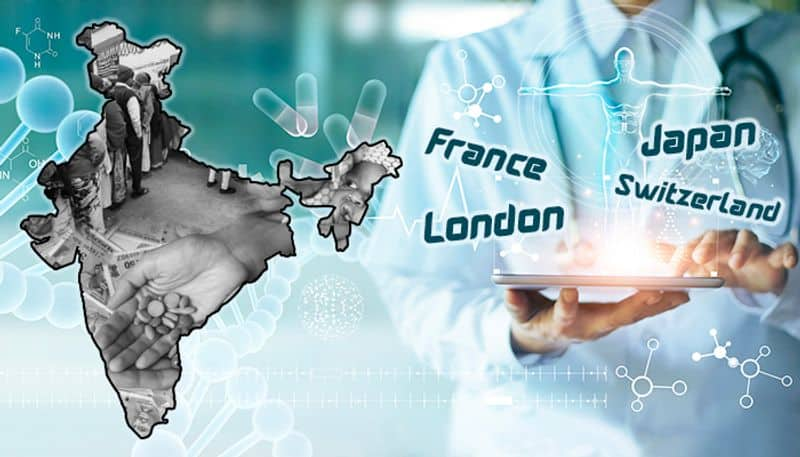Our public healthcare system supports 18% of outpatient services and 44% of inpatient service. Yet, the situation remains abysmal!
I have stayed in London for a few years of my life and my experience there has indeed opened my eyes towards the public healthcare system. The government hospitals provide over 80% services, and the government fixes the salaries of the doctors, nurses and the other staff. Even in my stint in Japan, I noticed that the government sets a fixed price for the services of private doctors. This eliminates all chances of over-billing, which is of course, heavily penalised.
Also read: Golwalkar – The man who integrated Kashmir with India, but never even got a thank you note
When I was in France, I saw that their system was slightly different. Over there, everybody must buy a health insurance, and that is sold by a small number of non-profits, who are tax funded. This public insurance covers over 70 to 80% of the costs. The rest is covered by voluntary insurance, which leaves little to absolutely no 'out of pocket' expenditure. In fact, over 95% of the population has voluntary insurance either through their jobs or vouchers. The government also fixes the prices of the various procedures and medicines and this costs the government 11.8% of the GDP.
When I was in Switzerland, I got to witness their universal health care system first-hand. This was similar to the Affordable Care Act of the United States of America. Here, it is the private companies who provide insurance, which is compulsory for all to buy. Usually, it is not-for-profit, but we do sometimes see for-profit coverage for added services or choice of hospitals. The doctors function on a national-fee-for-service scale and patients get to select any doctor of their choice. Oh, and the taxes for the middle-income group is abysmally low there. For my income of CHF 120k, I used to pay only 12.5% income tax.
Despite my early years in India, it was astonishing for me when I came to know that India has only 10 lakh registered doctors for its 1.3 billion people. And if we are to believe MCI claims, half of the doctors in India are unregistered or do not hold a record in allopathy. While the cities are slightly better off in this regard with 58% being qualified doctors, the rural areas have only a meagre 18% registered doctors. India just spends 1.2% of its GDP on health care, which is only marginally better than Myanmar, Pakistan and Cambodia.
Let us now talk about the bizarre availability of our public healthcare system. We just have one allopathic government doctor per 10,189 people. Oh, this isn’t the end of our miseries. We have only one hospital bed per 2046 people and one government hospital per 90,343 people. Only 10% of the 1 million doctors in the country join the public health structure.
Moreover, we have all witnessed the condition of government hospitals. They lack good infrastructure, management, staff and even basic hygiene! Something we should not be expecting as taxpayers.
22.4% of our population still live below the poverty line and solely depend on the government for all their healthcare needs. But when do we get to hear about government hospitals? It is only when there is a mishap, gross mismanagement or negligence! That is the sad story of our healthcare system. India has spent only 1.28% of its GDP as public expenditure on health for the year 2017-2018. The figure was 1.02% of the GDP for the year 2016-17. While India’s per capita public healthcare expenditure has increased more than twice from Rs 621 per person in 2009-10 to Rs 1,657 in 2017-18, it still is extremely poor when we compare it to other countries around the globe. The highest in this regard is United States of America, which spends 18% of its GDP, which is over $10,000 per person a year. India’s health expenditure is also the lowest when compared to her BRICS counterparts. The present government has promised to increase public health expenditure to 2.5% of the country’s GDP by 2025, but this still is definitely not enough.
As per the NSSO survey of 2013-14, around 36 million households in our country spent more on health emergencies than their per capita consumption. It consisted of 25 million rural and 11 million urban households. Over 39% of the poor in our country do not receive any medical treatment before death, which means that one-third of our population do not receive any medical attention before their death. Maybe, if our healthcare system was strong enough, we could have prevented this! The absence of a robust public healthcare system and the staggering cost of private healthcare system often prevent the citizens from venturing forth lest they fall into a debt trap. Illness already is disempowering, but with these added issues, they fall way down the ladder in terms of both power and influence.
So, how do we fix this?
First and foremost, we need to increase the government expenditure on healthcare. The government health infrastructure needs to improve, both in terms of accessibility and in terms of services. Moreover, the government should intervene in the pricing of private health care system. We often see absolutely absurd pricing for simple procedures in private hospitals. The government should fix a band for all services that are offered by the private hospitals.
PM Modi’s Ayushmaan Bharat scheme is definitely a step in the right direction. But there is still a long way to go. I sincerely hope that this government continues to take such steps which shall benefit us all. After all, health is wealth indeed, and no country can be prosperous with their citizens lacking basic healthcare.
About Abhinav Khare
Abhinav Khare is the CEO of Asianet News Network and also the host of a daily show named Deep Dive with AK. He has a lifetime collection of books and gadgets and has already pinged more than hundred cities around the globe.
He is a tech entrepreneur, who is passionate about policy, technology, economy and philosophy from ancient India. He earned an MS Engineering from the ETH Zurich and an MBA Finance from the London Business School.
Last Updated Feb 20, 2020, 5:06 PM IST











![Salman Khan sets stage on fire for Anant Ambani, Radhika Merchant pre-wedding festivities [WATCH] ATG](https://static-ai.asianetnews.com/images/01hr1hh8y86gvb4kbqgnyhc0w0/whatsapp-image-2024-03-03-at-12-24-37-pm_100x60xt.jpg)
![Pregnant Deepika Padukone dances with Ranveer Singh at Anant Ambani, Radhika Merchant pre-wedding bash [WATCH] ATG](https://static-ai.asianetnews.com/images/01hr1ffyd3nzqzgm6ba0k87vr8/whatsapp-image-2024-03-03-at-11-45-35-am_100x60xt.jpg)



